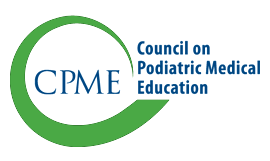What is CPME, and what does it do?
The Council on Podiatric Medical Education (CPME) is an autonomous accrediting agency for podiatric medical education. Deriving its authority from the House of Delegates (HOD) of the American Podiatric Medical Association (APMA), the Council is empowered to develop and adopt standards and policies as necessary for the implementation of all aspects of its accreditation, approval, and recognition purview.
The Council has final authority for:
- the accreditation of colleges of podiatric medicine;
- the accreditation of fellowships and residency programs;
- the accreditation of providers of continuing education; and
- the recognition of specialty certifying boards for podiatric medical practice.
What is the Council’s mission?
The Council’s mission is to promote the quality of graduate education, postgraduate education, certification, and continuing education. By confirming these programs meet established standards and requirements, the Council serves to protect the public, podiatric medical students, and doctors of podiatric medicine.
Is the Council recognized by the US Secretary of Education?
Yes. The Council is recognized by the Council for Higher Education Accreditation (CHEA) and the US Secretary of Education as the accrediting agency for first professional degree programs in podiatric medicine. CPME’s recognition by these organizations has been extended for the maximum periods available over the past several review cycles without any deficiencies. Although recognition by CHEA and the US Secretary of Education applies only to the Council’s activities related to the colleges of podiatric medicine, other Council activities follow the same stringent rules required by these entities.
Is CPME an autonomous agency?
Yes. The CPME is completely autonomous. Per the CPME Bylaws, “The Council shall be autonomous in conducting all aspects of its evaluation, accreditation, approval, and recognition functions, including but not limited to the establishment of bylaws, standards, requirements, and procedures; allocation of budget and expenditures; implementation of its own rules and procedures; selection of its own members, officers, committee members, evaluators, and consultants; and administration of its own affairs on behalf of APMA which are within its control.” (Ch. 2, Sec. 1.A. of the CPME bylaws)
Does CPME report to the APMA House of Delegates?
No. The CPME provides a report annually to the APMA HOD as well as to other organizations (e.g., APMA Board of Trustees [BOT], the American Association of Colleges of Podiatric Medicine [AACPM], and the Council of Teaching Hospitals [COTH]), but the CPME does not report to these entities. Per the CPME Bylaws, “The House of Delegates is the legislative and governing body of APMA. The House of Delegates designates the Council to act as the agency for the evaluation, accreditation, approval, and recognition of educational institutions, providers, programs, and specialty boards in the field of podiatric medicine. The Council shall provide a report annually to the House of Delegates.” (Ch. 2, Sec. 1.B. of the CPME bylaws)
Does the APMA House of Delegates have the authority to direct the actions of CPME?
No. CPME will provide due consideration to resolutions concerning the Council’s policies and procedures, but this in no way means that the APMA HOD, BOT, or other constituents have the authority to direct the actions of the CPME. The Council is a completely autonomous agency, and this independence is important to ensure impartiality and consistency, as well as restriction of all outside influences. The CPME Bylaws state, “The Council shall accept for consideration resolutions to the CPME submitted by the House of Delegates, Board of Trustees, and other constituents regarding CPME policies and procedures. The Council shall review and provide due consideration of these resolutions in the light of their feasibility and appropriateness. The Council shall provide a report when it deems appropriate to the presenter of the resolution regarding the action taken.” (Ch. 18, Sec. 3 of the CPME bylaws)
What is CPME’s relationship with APMA?
CPME is an autonomous organization that is housed within APMA. There is a strict firewall between APMA and CPME, and APMA is treated as any other “outside” agency by CPME. Information concerning CPME activities is not shared with APMA except that information which is made public to the community of interest. APMA does not review or make recommendations on CPME information before public release.
Where can I find information on actions taken by CPME?
Once CPME finalizes accreditation or approval actions, this information is posted on the CPME home page under the title “Resources/Actions.” In addition, all accreditation actions associated with the colleges or schools of podiatric medicine appear within the “Podiatric Medical Colleges” tab, under “List of Podiatric Medical Colleges.”
Who sits on the Council?
The Council consists of 11 members including the officers elected by the Council. The makeup of the Council reflects the various perspectives of the community of interest to include:
- eight at-large members who broadly represent the educational and practice communities within podiatric medicine including at least one representative each from the practitioner, educator, academic, and administrator communities;
- two public members who meet the definition provided in the US Department of Education’s Requirements for Recognition of Accrediting Agencies; and
- one member from the postsecondary education community who has no vested interest in or financial relationship to the podiatric medical profession.
A listing of the Council members can be found on the CPME homepage under the title of “About the Council.”
How are individuals nominated and elected to serve on the Council?
The Council annually publishes an announcement in APMA News, on the CPME website, and in other relevant publications calling for candidates. The CPME Bylaws outline the qualifications for at-large positions (Ch. 7, Sec. 1.B. of the CPME bylaws). A prospective candidate must submit their qualifications no later than June 15. Names received by June 15 are transmitted to the Nominating Committee, which reviews each candidate’s qualifications. The Nominating Committee sends the ballot of qualified candidates to the Council office no later than 60 days before the fall Council meeting.
Elections are conducted at the fall meeting of the Council by closed written ballot and are administered by the CPME Executive Director. Candidates must receive a majority vote of the Council (at least six votes) to be considered elected to the available position. The CPME Bylaws contain additional procedures should a candidate fail to receive a majority vote.
Is the Council required to follow a conflict-of-interest policy?
Yes. The Council takes conflicts of interest very seriously. Per the CPME Bylaws, the Council strives to avoid conflicts of interest or even the appearance of a conflict of interest in all its activities. Individuals are expected to disclose conflicts of interest as they appear and to recuse themselves appropriately from such matters. No Council representative can participate in any way in a decision in which they have a pecuniary or personal interest (or the appearance thereof). Council members and standing committee members are prohibited from serving as hired/retained consultants to colleges and schools of podiatric medicine, residencies, fellowships, providers of continuing education in podiatric medicine, specialty boards, or other institutions or organizations within the jurisdiction of the Council, while serving as a member of the Council or standing committee. (Ch. 15 of the CPME bylaws)
All Council members sign the conflict-of-interest policy annually. The list of conflicts of interest of CPME members can be found here.
How often are CPME documents revised?
A comprehensive review of the documents occurs six years following the CPME adoption date of documents from the previous Ad Hoc Advisory Committee review. An interim review by the relevant standing committee occurs three years following the adoption of revisions from the previous Ad Hoc Advisory Committee review. “A series of Council publications shall be reviewed either by an Ad Hoc Advisory Committee or by a CPME committee. Review of a series of CPME documents by an Ad Hoc Advisory Committee shall occur six years following the adoption of revisions resulting from the previous Ad Hoc Advisory Committee review. An interim review by the Accreditation Committee, Continuing Education Committee, Residency Review Committee, or Specialty Board Recognition Committee is completed three years following the adoption of revisions resulting from the previous Ad Hoc Advisory Committee review.” (Ch. 18, Sec. 2. of the CPME bylaws)
When CPME documents are revised, is there an opportunity for public input?
Yes. Prior to writing the first draft of a CPME document scheduled for a comprehensive revision, a survey is sent out to the community of interest to gather input on what changes should be made to the documents. The Ad Hoc Advisory Committee reviews the survey results and any comment letters received and begins its work to revise the documents.
Once a draft of the revised documents is ready for CPME review, CPME votes to either approve or send back the documents for continued revisions prior to approval. Once the draft documents are approved, they are disseminated to the community of interest for a comment period of approximately 60 days. The CPME does not finalize any document changes affecting the accreditation and recognition functions until opportunity has been provided for input from the community of interest.
Additional questions? See the other CPME FAQs
What is the CPME?
Colleges and Schools of Podiatric Medicine
Residency Programs
Fellowship Programs
Continuing Education Providers
Specialty Boards





